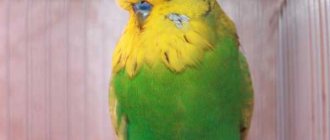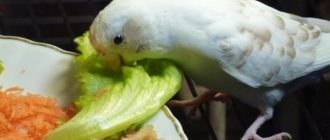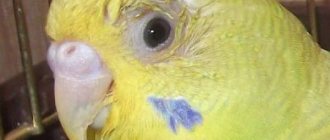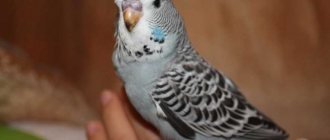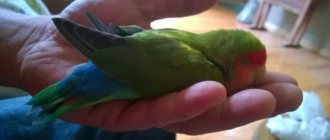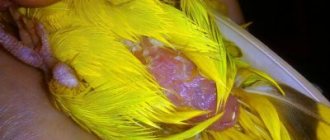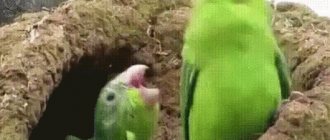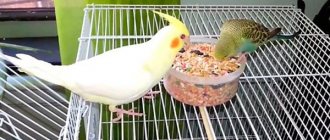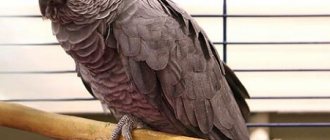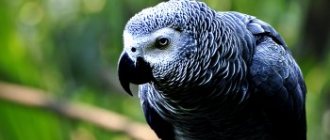Owners of budgerigars are confident that their pets will live long and carefree, delighting their owners with their trill every day. It is believed that in favorable conditions birds can live for decades. But there are always exceptions to the rules. Trouble comes unnoticed, and at one point the owner realizes that the parrot is seriously ill and will most likely die soon. What causes budgerigars, which are bred at home, to die if the birds were cared for according to all the rules? Our article provides an answer to this question.
How to understand that a parrot is dying
Serious illnesses or injuries are visible to the naked eye. The first thing that catches your eye is a decrease in activity, poor appetite, and general weakness of the pet.
How else can you tell that a parrot is dying? There are a number of signs:
- severe vomiting began;
- the bird does not stand on its legs and falls all the time;
- paws are straightened;
- neck tense;
- the parrot is having convulsions;
- jumps up and falls again;
- paralysis occurs.
Symptoms that a parrot is dying take several hours to several days to appear. But most often everything happens very quickly. Small birds have an accelerated metabolism. Therefore, pathologies develop in an instant.
The first signs of the imminent death of a bird
The death agony lasts from an hour to two to three days. The following symptoms may be observed:
- vomit;
- convulsions;
- running in circles, disorientation, chaotic movements;
- head thrown to one side;
- the paws are tense and unnaturally straightened;
- dull look, film on the eyes;
- the parrot lies at the bottom of the cage;
- paralysis.
The pet completely refuses to eat and drink, his strength leaves him and death soon occurs.
WHAT DO BUDGETS DIE FOR - BE SURE TO FOLLOW THIS
What to do if your parrot dies
If your parrot dies, you should see a veterinarian immediately. First aid will not be superfluous, it will alleviate the pet’s condition and help gain a few precious minutes.
So what can you do if your parrot dies? The action plan is:
- If traumatic shock or shortness of breath occurs, any corticosteroid, such as dexamethasone or prednisolone, must be administered intramuscularly.
- In case of fractures, the parrot should be immobilized so that in panic it does not injure itself further.
- Convulsions, chills - wrap the bird in a warm cloth.
- If your pet has inhaled toxic substances, paint, or gas, it is recommended to take it out into fresh air. At this time, thoroughly ventilate the room.
- If a parrot has swallowed a poisonous plant or spoiled food, you need to give it a sorbent several times throughout the day. That is, regular activated carbon or enterosgel.
- In case of vomiting or diarrhea, it is necessary to give 1 ml of glucose with saline every 10 minutes.
- If a chemical burn occurs, Solcoseryl eye gel will be useful. It needs to be inserted into the beak. Then apply to eyes and nostrils.
- In case of drug poisoning, it is worth giving the bird a sorbent first, and then, after a couple of hours, a laxative.
Differences in death
If the measures taken did not produce results and the pet stopped moving, alas, the pet’s death occurred. Signs of death are:
- Death of a pet. Rigor.
- Complete stillness.
- The paws are tucked towards the abdomen.
- Lying on his back.
- Closed eyes.
- Open beak.
- Lack of heartbeat and breathing.
Without a doubt, the death of a pet is an unexpected and sad event. And if the death of a parrot from old age is not perceived so acutely, then the loss of a young bird due to one’s own oversight can forever discourage the desire to have a pet. However, if you eliminate all risks, you can ensure your parrot has a long and happy life.
Why parrots die - causes of death
There are many reasons why parrots die. This includes the carelessness of the owner, illness, and injury. This also includes genetic and psychological factors.
Place of purchase
Spontaneous bird markets and dubious pet stores are not the best place to buy a parrot. Especially if a person does not know how to determine their age. An unscrupulous seller may sell an old bird. In appearance, it looks like a one-year-old individual. In this case, the cause of her death is old age.
In these same places they can sell a sick parrot. They may get sick due to inappropriate conditions or unbalanced food. This reduces immunity. The bird weakens before our eyes and then dies.
Injuries
The parrot receives them by flying out of the cage. It can crash into glass or a mirror, get burned, receive an electric shock, or become entangled in curtains. Owners and small children can also accidentally injure birds. They often become victims of attacks by other animals, such as cats or dogs.
Sometimes several parrots are kept in one apartment. In such situations, more active birds with leadership qualities offend weak, cowardly ones. They not only mutilate them, but also beat them to death.
The female dies if an egg gets stuck in her oviduct during laying.
Poisoning
Other options for why parrots die:
- Poisonous house plants, such as ficus, fern or milkweed.
- Polyurethane foam, glue.
- Household chemicals.
- Vapors from Teflon-coated products (iron, frying pan).
- Gas.
- Oil paints.
- Aerosols.
- Unnoticed fungi in bad feed.
The listed toxic substances lead to burns of the esophagus in birds, which subsequently leads to their death.
Poor nutrition
You can kill a pet out of ignorance. Little children often want to pamper their pet and feed them something tasty. But there are some foods that are strictly contraindicated for budgies. First of all, these are fruits in sugar, melons, watermelons, mangoes, persimmons, papaya. Potatoes in any form are prohibited for budgies. The causes of death can be herbs, some types of nuts, salty and canned foods.
Watch what the bird eats, explain to children what can be given and what cannot be given, and buy only high-quality and proven food.
As you can see, if you follow some rules of caution, monitor the cage and clean it in a timely manner, and also feed your budgie correctly, you can extend its life. Monitor the condition of the bird, especially during changes in environment or other stressful situations, and do not hesitate to contact a specialist if necessary.
What can a budgie die from?
There are many reasons why a wavy bird can die. In the first place is the negligence of the owners. The birds are modest in size. Therefore, flying freely around the room, they are able to fly out even through a barely open window.
In second place is poor nutrition. Parrots have a fast metabolism. Poisoning develops in a matter of minutes. And for this it is not necessary to inhale toxic fumes. It is enough to taste food from a person’s table. This applies to chips, sausages and sweets.
If your budgie is shaking
Trembling in itself is not considered dangerous to the health of the parrot, and it can be caused by disturbances in feeding or inappropriate living conditions. By correcting the shortcomings, you can easily improve the situation.
But if the trembling of the wings and tail does not go away, and the measures taken by the owner do not give the desired result, then this indicates the onset of the disease. A sick bird is shaking, its feathers are ruffled, the pet often sleeps for a long time, leaning its belly on the perch. At the same time, it does not react to extraneous sounds, does not make contact, and does not clean its feathers. Symptoms of the disease are:
- Lack of appetite. Complete refusal of food, drink and treats.
- Self-plucking. A large number of feathers with traces of blood is a very alarming sign.
- Constant scratching. Possible parasite infection.
- Difficulty breathing with the appearance of shortness of breath.
- Change in consistency and color of droppings.
- Refusal to walk around the room.
- Trauma, broken limb, open wound.
- Oral burns from feeding too hot food.
- Poisoning.
- Uncharacteristic scream.
- Loss of coordination in space.
- Purulent discharge from the cere.
If any of the symptoms are detected, you should not treat yourself. It is necessary to visit a veterinarian for diagnosis and treatment. Delay often threatens the death of your pet.
What to do if the parrot died
Due to confusion and depression, the owner of a dead bird may not immediately understand what to do with it. The pet needs to be buried. Then treat his cell.
How to bury
So, how to bury a parrot? This cannot be done within a populated area. Therefore, it is better to choose a place in the nearest forest or planting. Place the pet wrapped in cloth in a hole about 50 cm deep. Bury it. Sprinkle the top of the grave with branches or stones. This will help protect it from animals. If desired, the burial site can be marked with a flower or some other plant.
You can bury a parrot in a country house or in the courtyard of a private house. An area under a large tree is suitable for these purposes.
Nowadays, burial services for pets, including parrots, are increasingly being offered. They can be cremated.
Cell disinfection
This procedure will prevent the spread of the disease or infection that caused the parrot's death. Before it is carried out, it is strictly prohibited to place new inhabitants in the cage.
For disinfection, you need to prepare a solution of 1 tbsp. Ecocida-S and 1 liter of clean water. After putting on a respirator and rubber gloves, you need to thoroughly spray the cage with the resulting product. Leave for 30 minutes. Rinse with plenty of water and dry.
The treated cage should remain empty for at least another week. During this time, toxic substances will completely disappear from it.
Other factors
The lifespan of a budgerigar can be influenced by a number of other factors independent of the pet itself. First of all, these are genetics and the conditions of keeping the bird.
Place of purchase
Sellers at poultry markets are not always honest with buyers and may slip old birds. In addition, only a specialist can determine the exact age of a bird after a year. The same applies to hidden diseases, so it is better to buy a pet in trusted pet stores.
Genetics
Through the process of crossing, breeders try to produce remarkable individuals. But sometimes the results of their work manifest themselves in diseases inherent at the genetic level. It is very difficult to recognize such an individual. When buying a pet, experts recommend sticking to classic shapes and colors.
Bird living conditions
If the owner cleans the cage from time to time and uses mediocre products as food, then the bird will not last long in such conditions. She faces problems with the gastrointestinal tract, infections and parasites. All this shortens the life of the parrot.
Floor
It has been noticed that male birds at home live longer than females due to the double sex chromosome. While in the wild the opposite is true. Competition for mates and territory is a consequence of the death of many males.
How to cope with the death of a pet
There is no clear answer to how to survive the death of a parrot. Every time you remember him you will feel sad. And that's absolutely normal. For many, pets, even small ones, become family members.
Don't blame yourself for what happened. This will not bring the parrot back. Those who are faced with the same problem will help to survive the loss. You can find such people on forums on the Internet or among your own friends.
Knowing how a parrot dies will help you provide first aid to your pet if something suddenly happens. Perhaps timely actions will prolong the bird's life until a visit to the veterinarian. If the bird does die, you need to bury it in the ground and disinfect the cage. Only after this can new pets be placed there.
Why do birds die at home?
In the wild, birds rarely live beyond 4 years. While at home a pet can live all 15 .
There are also centenarians who reach the 20-year mark, but this is the exception rather than the rule.
Accidents
Almost anything can happen here, from a head stuck in the bars of a cage to careless actions of the owner. Let's look at the most common causes of bird death from accidents.
Drowning
Budgerigars love water, and use its mirror surface as a play tool. But if a bird doesn't know how to swim, it can drown. Before letting your pet fly freely around the room, vases with water and aquariums should be removed from the room.
When purchasing a swimsuit, you need to take into account the size of the bird. For budgies, small containers are suitable, where the bird cannot drown even if it wants to. Whereas larger solutions, for example, for cockatoos or grays, carry danger.
Flew out onto the street
Here it is also necessary to prepare the room for flights by closing all the windows and doors . If a parrot finds itself on the street, in an unfamiliar environment, it may become confused: run into an obstacle, fall into the blades of a split system, or simply freeze from the cold.
Burn
When releasing a parrot from its cage, you should limit its flights around the kitchen, where devices and equipment dangerous to the life of the animal are concentrated. A stove, toaster, or any other heating device that is turned on can seriously injure a bird.
Other animals
If there are other pets in the house besides the bird, then it is more advisable to limit contact with them. Cats are kind and affectionate with their owners by nature as predators: it is very difficult to avoid the temptation to hunt a bird. Dogs are safe for parrots, but due to their large weight and clumsiness, they can accidentally crush the pet with their paw or body.
Small children
Children love animals and, when showing their feelings, they can inadvertently harm a fragile bird by squeezing it tightly or feeding it food that is harmful to the bird. Games with a parrot should be supervised by parents. If the child is of kindergarten age, then contacts should be limited to placing the bird on the palm.
As soon as a pet appears in the house, children should immediately be explained that it is not a toy, but a family member, and should be treated accordingly. It is necessary to teach the child to ask permission to open the cage and other contact actions.
Parasites
Ixodid ticks
Parrots in poor living conditions have a large number of external parasites (ectoparasites). These are ixodid and gamas ticks. Ixodid ticks attach to the skin of chicks and adult birds. They are visible to the naked eye as gray “warts”, up to 1.5 cm in size. They feed on blood. If there is a severe degree of mite infestation, the parrot may die from exhaustion. These mites are carried by rodents. Also, ixodid ticks can get into an apartment with branches, greenery, and hollows from the street. Treatment consists of removing ticks from the parrot using any acaricidal preparations. Those. The parrot needs to be treated with antiparasitic agents. These ticks can attack humans and other pets.
Gamasid mites
Gamasid mites are very mobile, small (up to 1 mm), bright red arthropods that live in cracks in walls during the day and in any other places where they can hide from sunlight; they attack birds at night. They feed on blood and lymph. They do not stay on the birds themselves for long, so these mites cannot be detected during an external examination. The problem is relevant when keeping parrots in aviaries, although it occasionally occurs in apartment conditions.
The problem is solved by regular thorough cleaning of the premises with birds, proper organization of bird rooms, and insecticidal preparations that are used to treat the premises, not the parrots.
Pere-eaters
Pere-eaters (mallophagous) of parrots. They feed on feathers and down. Visible to the naked eye as gray and black lines up to 8 mm in size (usually 2-3 mm) at the edge of the feather. Gnawed holes appear in the feather.
Attention! Smooth transverse stripes on the feather, which are formed from a number of holes, are stress lines. Stress lines have nothing to do with feather eaters, but these lines indicate other serious health problems with the parrot.
Treatment for feather eaters is simple: insecticidal preparations are applied to the parrot's skin. But be sure to consult with your veterinarian, as some drugs are very toxic if used incorrectly.
Bloodsucker flies
Bloodsucking flies, or moose flies, can also parasitize parrots, especially when kept in an aviary. These flat flies, up to 1 cm in size, move very quickly between feathers and can be noticed either during an external examination of the parrot, or by accidentally seeing them on the bird. They usually do not create a big problem, although they bother the parrot and theoretically can carry various infections. Treatment for bloodsucker flies involves treating the parrot with insecticides. A single treatment is sufficient. These flies can fly to other domestic animals and are theoretically capable of biting humans.
Scabies mites
The most common external parasites of parrots are scabies mites - Knemidocoptes. These mites live in the thickness of the skin, drilling passages in it, because of this the skin thickens and becomes like a honeycomb, and growths of various shapes appear. The mites themselves are visible only under a microscope. This disease is called knemidocoptosis. Budgerigars are most often affected, less often other species of parrots, although cnemidocoptic mange has been recorded in all species of parrots, including large ones (macaws, cockatoos, Amazons).
Parrot owners most often notice this disease when white growths around the beak (often described as horns around the beak) become visible and when the beak itself is already deformed. It is important to know that along with the skin around the beak, the skin of the paws and the skin in the cloaca area are affected. The disease develops chronically, i.e. the beak does not bend immediately. It is important to know that knemidocoptic mange is a marker that the bird is kept in poor conditions and that additional examination is necessary to identify concomitant infections.
Treatment of parrots for knemidocoptic mange is simple; it involves treating the bird with insecticides in the form of sprays, ointments, and injections. The most advanced cases of knemidocoptosis require treatment for a month; in budgerigars it is usually possible to cope with this parasitosis in 7-10 days. All growths fall off on their own during treatment - no need to cut them off. A severely deformed beak must be trimmed long after the mites have been cured. It is very important at the beginning of treatment to completely replace everything that can be replaced in the cage (perches, toys, swings, etc.), and thoroughly scald the cage itself, feeders and drinkers, since scabies mites and their eggs are well preserved on perches and toys and everything that surrounds the bird. Exactly the same treatment is carried out after the parrot has been treated for knemidocoptic mange. Those. treatment must be carried out at the beginning and at the end of treatment. For humans and other pets, parrot scabies is not dangerous.
The video explains in more detail about knemidocoptic mange in budgerigars.
Endoparasites
Parrots, like all other vertebrates, can have a large number of parasites living in the intestines, blood or body cavities.
The most common protozoan parasite affecting parrots is Giardia. Giardia causes the development of giardiasis. Signs of giardiasis in parrots, as is often the case, are nonspecific: lethargy, diarrhea, feather plucking in the armpits. Giardiasis is one of the common causes of self-plucking in cockatiels. This is due to the fact that when giardiasis occurs in cockatiels, the intestines become inflamed, the liver and glandular stomach increase in size - all this is very painful for the parrot, and as a result the bird begins to pluck itself, trying to get rid of the pain. Giardiasis in parrots is dangerous for both humans and other domestic animals, so during treatment it is necessary to take precautions and carefully treat the cage and care equipment with disinfectant solutions.
No less common parasitic diseases of parrots are coccidiosis and hexamitosis. These diseases are common in budgies, cockatiels, and lovebirds. There are no specific signs of these diseases. The diagnosis is made based on laboratory detection of parasites in the droppings of sick parrots. These parasites are harmless to humans and other pets.
Worms
Look at these photos of parrots with helminthiasis and how many worms they had. White and beige worms are excreted roundworms that lived in a budgie and cockatiel before a course of anthelmintics was administered.
If a parrot has a lot of worms, as in these photos from an Australian bird hospital, then a course of anthelmintic drugs should be carried out only under the supervision of a avian doctor, because the massive death of worms after anthelmintics can lead to blockage of the bird’s intestines.
Let me note that in the wild, helminths are practically not found in parrots. The reason that helminth infections in parrots is a common occurrence in captivity is a violation of the basic conditions for maintaining the health of parrots: improper feeding, low mobility, overcrowding when keeping birds, lack of normal social communication between parrots.
Remember that even if the parasitology test result is negative, it may be a false negative result.
Are you still deworming your parrots? But in vain, parrots need to administer a course of anthelmintic drugs at least once a year, and preferably 2 times a year.
Worms in parrots kept in captivity are quite common. You can read more about this in this article: Worms in parrots: symptoms, signs, prevention, diagnosis, treatment.
Parrots are long-lived animals. They get sick for a very long time. Most diseases occur in a chronic form.
Symptoms in parrots initially appear and then disappear, but the diseases do not disappear, but develop. Therefore, at the first signs of illness or abnormal/unusual behavior, contact your veterinarian immediately.
An article about how to treat parrots, how to properly administer medications into the beak.
Bird doctor, veterinarian Kozlitin V.E.
References: 1. Avian medicine: principles and applications. Ritchie, Harrison and Harrison. © 1994. Wingers Publishing, Inc., Lake Worth, Florida
What to do if the wavy dies
Good grief, but you can’t leave a dead pet at home. He needs to be buried. The fact is that birds are carriers of dangerous diseases, so it is more advisable to carry out the burial procedure no later than the next day after death.
How to bury a bird correctly
Animals cannot be buried within the city limits. You'll have to look for a place in the nearest forest belt. The parrot's body is wrapped in a piece of cloth and buried about half a meter into the ground. To prevent animals from digging up the grave, you need to lay stones or turf on top.
What to do with the cage
You cannot add other birds to the cage where your pet died without first treating it. General cleaning with complete disinfection is required. Products for the latter can be purchased both in pet stores and pharmacies, describing the nature of the problem.
First actions
So, you have determined that your budgie is dying, what should you do? Provided that if the owner soberly assesses his capabilities and knows the symptoms of a particular situation, the first aid actions will be:
- Against vomiting and diarrhea. Soldering with liquid glucose and saline solution, 1 ml every 10 minutes.
- From a chemical burn. Solcoseryl eye gel is administered orally. They also treat the eyes and wax.
- For shock and shortness of breath. An intramuscular injection of glucocorticoid drugs is performed.
- For broken limbs. Immediate fixation is required.
- Hypothermia. You need to warm up your pet.
- In case of poisoning by toxic fumes. The cage with the parrots is moved to another room, the room is ventilated.
- In case of poisoning from a houseplant. Seal off with sorbents every hour.
If the owner is not confident in his actions, or does not know the cause of the disease, the first action will be to contact a specialist. Only in this case can the bird be saved.
How to treat a cell
If a parrot dies unexpectedly, it is recommended to find out the cause of death
This is especially important if there are other birds in the house. If there is a veterinary clinic and laboratory in the locality and they will do this, then this is an ideal option
Birds can suffer from contagious and dangerous diseases such as chlamydia, tuberculosis, and salmonellosis. Even if it was not possible to find out what caused the parrot’s death, the bird’s cage must be thoroughly disinfected.
You can treat the cage after the death of a parrot using the following means:
- Alkali;
- xylonaft 5%;
- creolin emulsion.
Before starting treatment, wear rubber gloves and protect your respiratory tract.
Disinfection is carried out if the pet suddenly died for unknown reasons or had parasites, bacterial and viral infections.
Contagious diseases
Parrots suffer from a large number of infectious diseases. Some infections are common to humans and parrots. Such infections are called zooanthroponoses. Owners of parrots need to know that humans pose a great danger to the parrot, because most of the normal human microflora (bacteria that live in the mouth and on the skin) is dangerous for parrots because it causes them to develop acute and chronic infections, such as escherichiosis, staphylococcosis. For this reason, humans need to avoid kissing and mouth feeding parrots. Infectious diseases of parrots that are dangerous to humans are very common, so you need to get tested for these infections immediately after purchasing a parrot, or better yet, before purchasing a bird.
Signs of contagious diseases in parrots and parakeets are varied, but none of them are specific. Those. It’s impossible to say for sure - if a parrot has discharge from the nostrils, then this is, for example, psittacosis, etc. Symptoms depend on which organ system is most affected, and if the infection develops in all organs of the bird, then multiple organ failure develops and all the symptoms of a sick parrot can appear at the same time - most often this is frizz, decreased activity, refusal to eat.
